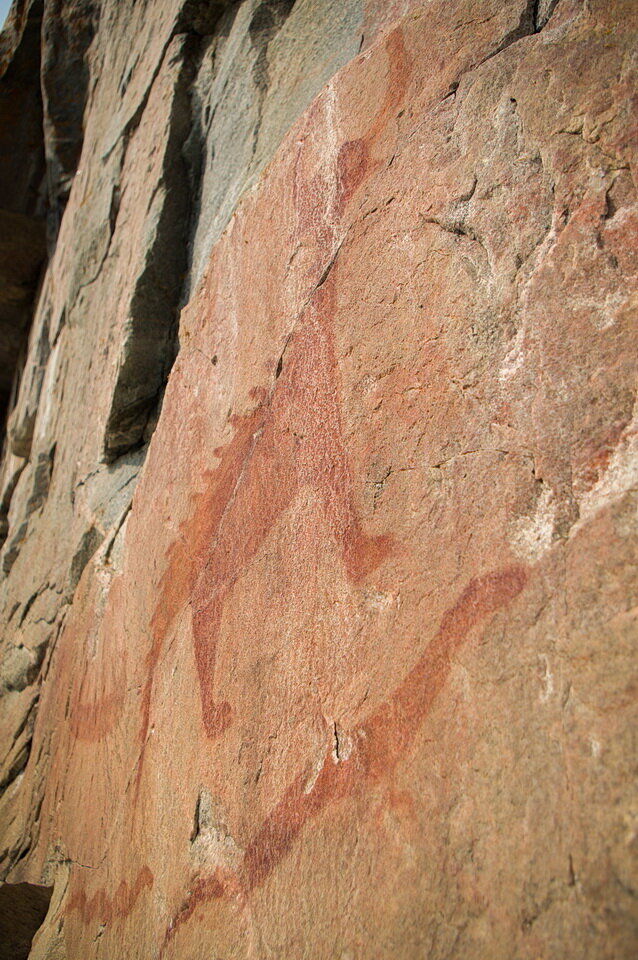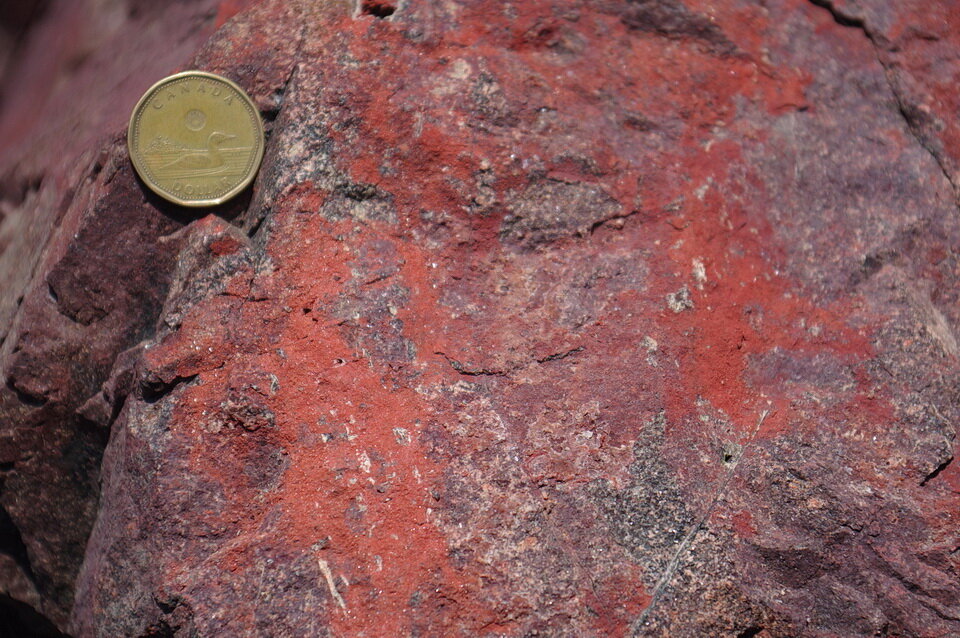Geochemistry: Chemical Weathering And Ochre
Iron, Culture And Spirituality
Iron in the Earth plays many important roles in human culture, science, and commerce. Perhaps one of the more familiar uses of iron was to make tools during a cultural period called the Iron Age. Iron also played an important role in the creation of rock art by ancient peoples. Ancient people used red and yellow minerals, such as hematite and limonite, to make red and yellow pigmented ochre respectively. Those pigments were used to create body and rock art.
One example of the use of red pigment to make culturally and spiritually significant rock art are the well known Agawa Rock pictographs (Photo 1) exposed on a cliff face, beside Lake Superior, in the Lake Superior Provincial Park, Ontario, Canada.
Photo 1: Mishipeshu, the Great Lynx (top centre), is one of the red ochre pictographs on the cliff face beside Lake Superior, Lake Superior Provincial Park, Ontario, Canada. Shown with respect. I confess that I was not happy climbing on this ledge, which sloped into the cold waters of Lake Superior. Image by Andy Fyon, Aug. 19, 2018.
In this note, I describe a geological process that creates red ochre by chemical weathering of iron-bearing rock minerals that originated deep in the Earth. That red ochre may have been the type used by First Nation Ojibway people to create these Agawa Rock pictographs, as well as other pictographs in the Lake Superior basin.
Now, I am not an archaeologist. I have not seen any ochre pits in the Lake Superior basin; but, I have seen specular hematite and red ochre powder on chemically weathered diabase rocks along the coastal trail, south of Gargantua Bay. What I describe is a simple process by which that ochre can form.
Chemical Transformation Of Iron
Chemical weathering at the Earth’s surface is a very simple way to liberate and transform iron, bound in the crystal structures of olivine and pyroxene minerals, into red-coloured, secondary ochre.
Chemical weathering at the Earth’s surface involves the chemical reaction between rock and its minerals with water, carbon dioxide (CO2) dissolved in the water, carbonic acid (H2CO3) made naturally when water reacts with carbon dioxide, and free oxygen from the atmosphere or soil. A a detailed description of chemical weathering will be presented elsewhere.
Chemical stability of olivine and pyroxene
Olivine ((Mg, Fe)2SiO4) and augite pyroxene ((Ca, Na)(Mg, Fe,)(Si, Al)2O6) minerals make up the igneous rocks called dunite, peridotite and gabbro (or basalt or diabase). Those rocks formed deep in the Earth. Both olivine and pyroxene contain iron that is tightly bound in their mineral structures. Chemists say that iron is “reduced iron” and is denoted as Fe2+ when writing a chemical reaction. The rocks, and their minerals, are not chemically stable at, and near, the Earth’s surface where they are transformed by chemical weathering into new, secondary minerals that are chemically stable at the Earth’s surface.
Chemical weathering of olivine and oxidation of iron
There are several reaction steps that describe the liberation of reduced iron from olivine or pyroxene mineral structure and the formation of a secondary iron oxide mineral. I will illustrate the chemical reactions by primarily using the mineral olivine, for simplicity; however, the reaction steps are the same for pyroxene.
Step 1: liberate reduced ferrous iron (Fe2+) from the olivine mineral structure by chemical weathering:
(Mg,Fe)2SiO4+ 4H2CO3 --> 2Fe2+ + 4HCO3– + H4SiO4
Olivine + Carbonic Acid --> Liberated Reduced Iron + Dissolved Carbonate Ion + Dissolved Silicic Acid
Step 2: free oxygen (O2) converts reduced ferrous Fe2+ iron, which is liberated from the olivine or pyroxene minerals, to its oxidized iron form (Fe3+):
4Fe2+ + O2 + 4H+ --> 4Fe3+ + 2H2O
Ferrous Iron + Oxygen + Acidity --> Ferric Iron + Water
Step 3: oxidized Fe3+ iron is quickly tied up with the free oxygen to form a secondary iron oxide mineral. In this case, I have shown the formation of iron oxide mineral called hematite (Fe2O3), which is stable at the Earth’s surface:
4Fe3+ + 3O2 --> 2Fe2O3
Oxidized Ferric Iron + Oxygen --> Hematite (red ochre)
or
4Fe3+ + 12H2O —> 4Fe(OH)3- + 12H+
Ferric Iron + Water —> Ferric Hydroxide (yellow ochre) + Acidity
It is also possible to write a chemical reaction equation that shows reduced ferrous iron (Fe2+) reacting with hydroxide ions (OH-) to directly form an oxidized secondary iron mineral:
Fe2+ (aqueous) + 2OH- (aqueous) —> Fe(OH)2 (solid mineral made of ferric iron)
Chemical weathering of pyroxene and oxidation of iron
For the mineral pyroxene, it is possible to write a chemical weathering reaction to show the direct creation of the secondary iron oxide mineral limonite:
CaFeSi2O6 + H+ —> Ca+2 + FeO(OH) + 2SiO2
Pyroxene + Hydrogen ion —> Calcium ion + Limonite + Quartz
Secondary iron oxide minerals
The secondary iron oxide minerals hematite and limonite are only two of several secondary iron oxide minerals that can form as a result of this type of chemical weathering and oxidation of iron.
Relevance To Ochre
What does this have to do with the formation of red or yellow ochre? Yellow and red coloured ochre have been used culturally by First peoples around the world to make pigments. Those pigments were used to make rock art and body paint. The secondary oxidized iron mineral, hematite or limonite, are the foundation of ochre. Hematite makes red ochre and limonite makes yellow ochre.
So, the chemical weathering of deep Earth minerals, like olivine and pyroxene, and their rocks, creates red and yellow-coloured iron oxide mineral pigments as a by product.
Along the coast trail, in Lake Superior Provincial Park, there are examples where diabase rock, composed of pyroxene (and iron-bearing amphibole and plagioclase feldspar) were chemically weathered. The weathering products include tiny, silvery or black sooty grains of specularite hematites as well as powdery, red ochre pigment (Photo 2).
Photo 2: The black arrows point to shiny crystal faces of what appears to be specular hematite. Other arrows point to black sooty iron minerals. The red powdery material is red ochre that has formed on the fracture face. The original rock was diabase - an igneous rock that formed deep in the Earth and that has enjoyed chemical weathering on the Earth’s surface. Photo by Andy Fyon, south of Gargantua Bay, along the coast of Lake Superior, Lake Superior Provincial Park, Aug.15, 2018.
When seen on broken rock surfaces, the powdery, red ochre is very distinctive (Photo 3).
Photo 3: This red-coloured surface consists of powdery red ochre that is forming from continued chemical weathering of exposed secondary iron oxide minerals like hematite. The powdery surface lies on a fracture surface, which is an ideal channel for groundwater to access and chemically weather the diabase rock. The original rock was diabase - an igneous rock that formed deep in the Earth and that has enjoyed chemical weathering on the Earth’s surface. Photo by Andy Fyon, south of Gargantua Bay, along the coast of Lake Superior, Lake Superior Provincial Park, Aug.15, 2018.
I am not an archaeologist and I have not studied the red ochre used to create the rock art exposed on the shores of Lake Superior, but this simple explanation illustrates one possible geological process that created red iron oxide pigment that may have been used by First Nation people for cultural and spiritual purposes.
Summary: Chemical Weathering, Iron Oxidation, And Red Ochre Pigment
In this area along the coast of Lake Superior, in Lake Superior Provincial Park, chemical weathering of diabase igneous rock and oxidation of ferrous iron liberated from the mineral structures of pyroxene (and olivine?) in the original diabase rock were, and are, active geological processes that created secondary iron oxide minerals, including hematite. Perhaps further chemical weathering of the secondary hematite created the red ochre powder. That hematite is present as tiny silvery grains (variety specularite) and as a red powder along fractures in the weathered rocks. Those secondary iron oxide minerals are the foundation pigment for red ochre.
The presence of secondary hematite demonstrates that chemical weathering is one geological process by which red iron pigments were created for First Nation cultural and spiritual use.
Andy Fyon: Sept 25/20



